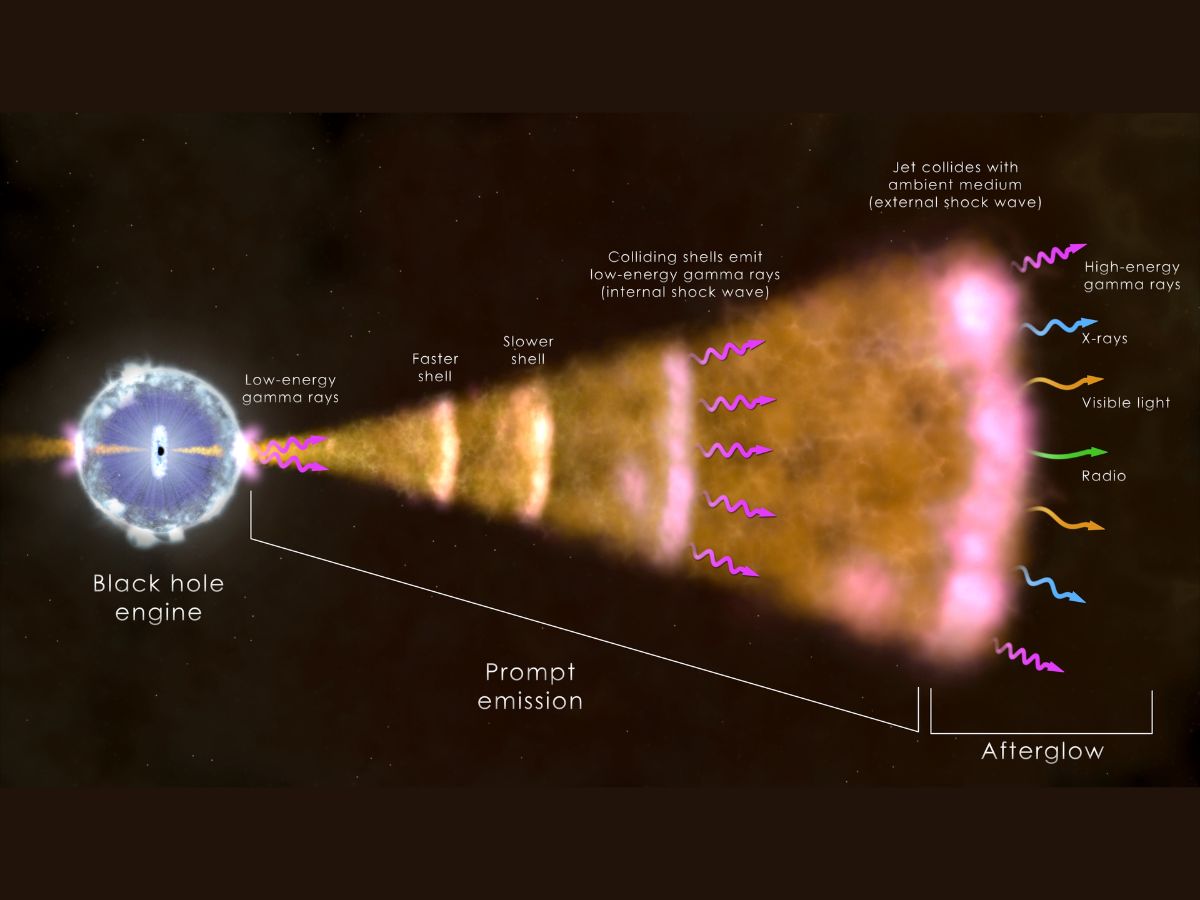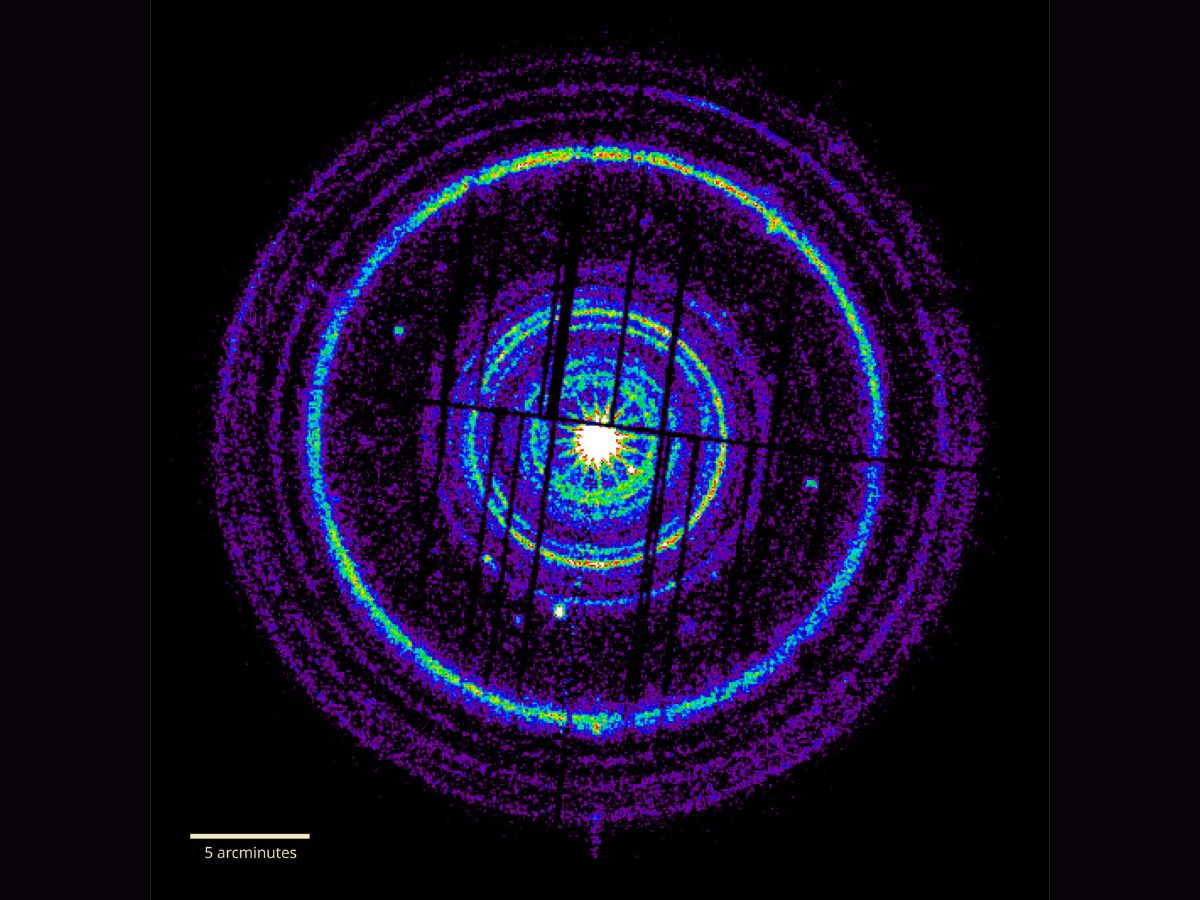Cosmic Explosion Observed In October 2022 Is The Brightest Ever Recorded, May Be A 1-In-10,000-Year Gamma-Ray Burst
The cosmic explosion has been named GRB 221009A for its discovery date. It is the brightest gamma-ray burst ever recorded, according to a new study published March 28.

An intense pulse of gamma-ray radiation swept through the solar system on October 9, 2022, triggering gamma-ray detectors on numerous orbiting satellites, and spacecraft. The radiation was so bright that astronomers decided to study the event using the most powerful telescopes in the world.
The cosmic explosion has been named GRB 221009A for its discovery date. It is the brightest gamma-ray burst ever recorded, according to a new study published March 28 in The Astrophysical Journal Letters.
Gamma-ray bursts are the most powerful class of explosions in the universe.
Voyager 1 was the first to detect the gamma-ray burst
Voyager 1, which was launched in 1977, is now more than 20 billion miles from Earth, and has identified more than 10,000 gamma-ray bursts during its journey. The spacecraft registered significant counts in its particle detectors for a brief time, on October 8, 2022. This marked the first detection of the brightest gamma-ray burst ever observed, according to the study.
The gamma-ray burst swept through the solar system, and was detected by instruments on more than a dozen satellites built for astrophysics, planetary science and solar observations.
Observations of the burst after it arrived at Earth
The burst arrived at Earth 19 hours after arrival at Voyager 1.
The Fermi Gamma-Ray Burst Monitor sent the first announcement of the gamma-ray burst. Due to real-time data issues, no location or classification of the event was sent.
NASA's Neil Gehrels Swift Observatory was triggered by a bright transient (an astrophysical phenomenon that changes its brightness over a relatively short period of time) near the plane of the Milky Way, an hour after the Fermi Gamma-Ray Burst sent the first announcement.
The Neil Gehrels Swift Observatory reported this as an unusual Galactic transient.
The automated response of the Fermi Large Area Telescope found a significant source of high-energy photons, the study said.
This resulted in the first consideration that the detections of the Fermi Gamma-Ray Burst and Neil Gehrels Swift Observatory may be the same event.
Triangulation of the Gamma-Ray Burst Monitor signal by the InterPlanetary Network to the same source position identified by the Neil Gehrels Swift Observatory confirmed the fact that both had detected the same event.
1-in-10,000-year burst, brightest burst since human civilization began
This was the brightest gamma-ray burst ever observed.
Since bursts this bright in the prompt, or initial phase, arrive at Earth roughly every 10,000 years, scientists believe it is the brightest burst since human civilization began.
The study describes the observations of GRB 221009A, spanning from radio waves to gamma-rays. Some of the critical millimetre-wave observations were made using the Center for Astrophysics | Harvard & Smithsonian's Submillimeter Array (SMA) in Hawaii.
The study reveals new mysteries about the origin of these extreme cosmic explosions, which astronomers have been trying to understand for decades.
The gamma-ray burst is believed to be the birth cry of a black hole
The gamma-ray burst lasted more than 300 seconds, and such "long-duration" gamma-ray bursts are believed to be the birth cry of a black hole.
When the core of a massive and rapidly spinning star collapses under its own weight, a black hole is formed, and a "long-duration" gamma-ray burst is released. This is because as the newborn black hole ingests the surrounding matter, it launches powerful jets of plasma at near the speed of light, in opposite directions, which pierce through the collapsing star and shine in X-rays and gamma-rays.
What happened after the initial burst of gamma rays?
Since GRB 221009A is the brightest burst ever recorded, scientists wondered what would have come after the initial burst of gamma rays.
In a statement released by the Center for Astrophysics, Tanmoy Laskar, assistant professor of physics and astronomy at the University of Utah, and lead author on the paper, said as the jets slam into gas surrounding the dying star, they produce a bright 'afterglow' of light across the entire spectrum. He added that the afterglow fades quite rapidly, which means that astronomers have to be quick and nimble in capturing the light before it disappears, taking its secrets with it.
How did astronomers study the afterglow of the burst?
Astronomers Edo Berger and Yvette Cendes of the Center for Astrophysics rapidly collected data using the Submillimeter Array, in order to study the afterglow of the gamma-ray burst.
Berger said the burst was so bright that it provided a unique opportunity to explore the detailed behaviour and evolution of an afterglow with unprecedented detail.
Expressing his delight at studying the powerful gamma-ray burst, Berger said he has been studying these events for more than 20 years, and GRB 221009A was as exciting as the first gamma-ray burst he ever observed.
Garrett Keating, a researcher at the Center for Astrophysics, said astronomers were able to quickly turn the Submillimeter Array to the location of GRB 221009A due to its rapid-response capability.
The afterglow was extremely bright, radio wave observations were brighter than expected
The afterglow of the gamma-ray burst was so bright that astronomers were able to continue monitoring it for more than 10 days as it faded.
The astronomers analysed and combined the data from the Submillimeter Array and other telescopes all over the world. The results surprised them because the millimetre and radio wave observations were much brighter than expected based on the visible and X-ray light.
Cendes said this is one of the most detailed datasets the team has ever collected, and it is clear that the millimetre and radio data just do not behave as expected. In the past, a few gamma-ray bursts have shown a brief excess of millimetre and radio emission. This is thought to be the signature of a shockwave in the jet itself.
However, in GRB 221009A, the excess emission behaves quite differently than in past gamma-ray bursts, Cendes said.
She added that it is likely that the team has discovered a completely new mechanism to produce excess millimetre and radio waves.
Visible and X-rays may have been produced by one portion of the jet, millimetre and radio waves by another
Cendes explained that it is likely that the powerful jet produced by GRB 221009A is more complex than in most gamma-ray bursts. She said it is possible that the visible and X-ray light are produced by one portion of the jet, while the early millimetre and radio waves are produced by a different component.
Berger said that the afterglow is so bright that researchers will continue to study its radio emission for months and maybe years to come. He said that astronomers hope to decipher the mysterious origin of the early excess millimetre and radio waves.
The gamma-ray burst blinded most gamma-ray instruments in space
According to NASA, the gamma-ray burst was so bright that it effectively blinded most gamma-ray instruments in space. As a result, gamma-ray instruments in space were not able to directly record the real intensity of the emission.
United States scientists reconstructed this information using NASA's Fermi Gamma-ray Space Telescope.
The gamma-ray burst was 70 times brighter than any yet seen
After this, the researchers compared the results with those from the Russian team working on data from the Russian Konus instrument on NASA's Wind spacecraft, and also with results from the Chinese team. The results together prove that the gamma-ray burst was 70 times brighter than any yet seen.
In a NASA statement, Eric Burns from the Louisiana State University said GRB 221009A was likely the brightest burst at X-ray and gamma-ray energies to occur since human civilization began. Burns and colleagues analysed about 7,000 gamma-ray bursts using NASA's Fermi and the Russian Konus instrument to establish how frequently such gamma-ray bursts may occur. The researchers concluded that a gamma ray burst like GRB 221009A occurs once in every 10,000 years.
Signal from the gamma-ray burst had been travelling for about 1.9 billion years before it reached Earth
According to NASA, the signal from GRB 221009A had been travelling for about 1.9 billion years before it reached Earth. This makes GRB 221009A one of the closest-known "long" gamma-ray bursts, whose initial, or prompt, emission lasts more than two seconds.
Why was a supernova not observed after the gamma-ray burst?
Astronomers hope to find a brightening supernova a few weeks after observing such a gamma-ray burst. However, scientists have found it difficult to observe such a spectacle.
The gamma-ray burst appeared in a part of the sky that is just a few degrees above the plane of the Milky Way, where thick dust clouds can greatly dim incoming light, and this could be a reason why astronomers were unable to observe a brightening supernova a few weeks after the discovery of the gamma-ray burst.
Andrew Levan from Radboud University in the Netherlands said astronomers cannot conclusively say there is a supernova, which is surprising given the burst's brightness.
Dust clouds become more transparent at infrared wavelengths. Therefore, Levan and colleagues used the James Webb Space Telescope to obtain near- and mid-infrared observations, and also the Hubble Space Telescope, to spot the supernova.
Levan said if a supernova is there, it is very faint, but it is possible the entire star collapsed straight into the black hole instead of exploding.
The radiation from a black hole and afterglow: explained
As the jets released by the newborn black hole continue to expand into material surrounding the doomed star, they produce a multi-wavelength afterglow that gradually fades away.

The above illustration shows the ingredients of a long gamma-ray burst. On the left, the image shows the core of a massive star that has collapsed, forming a black hole that sends a jet of particles moving through the collapsing star and out into space at nearly the speed of light.
In the vicinity of the black hole, low-energy gamma rays are emitted. There are shells of fast-moving gas within the jet. The faster and slower shells collide, and emit low-energy gamma rays, which form the internal shock waves.
The leading edge of the jet collides with the ambient or surrounding medium, forming external shock waves.
Hot ionised gas or plasma in the vicinity of the black hole, the internal shock waves, and the external shock waves together constitute the radiation across the spectrum.
In the end, high-energy gamma-rays, X-rays, visible light and radio waves are emitted, which constitute the afterglow.
Kate Alexander from the University of Arizona said that the gamma-ray burst, being so close and bright, offered researchers an unprecedented opportunity to gather observations of the afterglow across the electromagnetic spectrum.
She added that twenty-five years of afterglow models that have worked very well cannot completely explain this jet. The researchers found a new component they do not understand completely, and this may indicate an additional structure within the jet.
Alexander explained that the jets were not unusually powerful, but were extremely narrow, much like the jet setting of a garden hose, and one was pointed directly at Earth.
Astronomers probed distant dust clouds in Milky Way using X-ray rings from the burst
With the help of the burst, astronomers probed distant dust clouds in the Milky Way. The prompt X-rays were travelling towards the Milky Way. During their journey, some of the X-rays reflected off of dust layers. As a result, extended "light echoes" of the initial blast in the form of X-ray rings were created.
The X-ray Telescope on the Neil Gehrels Swift Observatory discovered the presence of a series of echoes, and together with details from the European Space Agency's (ESA's) XMM-Newton Telescope, it revealed that the extraordinary rings were produced by 21 distinct dust clouds.
Sergio Campana from the National Institute for Astrophysics in Merate, Italy, explained that how dust clouds scatter X-rays depends on their distances, the sizes of the dust grains, and the X-ray energies.
X-ray rings helped researchers locate dust rings in the Milky Way
Campana said that researchers were able to use the rings to reconstruct part of the gamma-ray burst's X-ray emission and to determine where in the Milky Way the dust clouds are located.
The brightest gamma-ray burst ever observed is only the seventh such cosmic entity to display X-ray rings. The number of X-ray rings displayed by GRB 21009A is triple the number of X-ray rings seen around gamma-ray bursts in the past.
Where were the dust rings located?
According to NASA, the light echoes came from dust located between 700 and 61,000 light-years away.
The most distant echoes were clear on the other side of the Milky Way. These echoes were 4,600 light years above the Milky Way's central plane, where the solar system resides.
Michela Negro, an astrophysicist at NASA's Goddard Space Flight Center, said the burst offers an opportunity to explore a big cosmic question, which is whether black holes, that are all-consuming things, also return power back to the universe.
Negro's team probed the dust rings with NASA's Imaging X-ray Polarimetry Explorer (IXPE) to see how the prompt emission was organised, and to obtain insights into how the jets form.
Researchers say that the brightest gamma-ray burst's jets could have been powered by tapping into the energy of a magnetic field amplified by the black hole's spin.

The above image shows the dust rings recorded by XMM-Newton. The telescope recorded 20 dust rings, 19 of which are shown in the image in arbitrary colours. The composite image has merged observations made two and five days after GRB 221009A erupted.
The dark stripes in the image indicate gaps between the detectors. The widest ring visible in the image is comparable to the apparent size of a full moon. The widest ring came from dust clouds located about 1,300 light years away.
The innermost ring was created by dust on the other side of the Milky Way. The dust was present at a distance of 61,000 light years away from Earth.






































